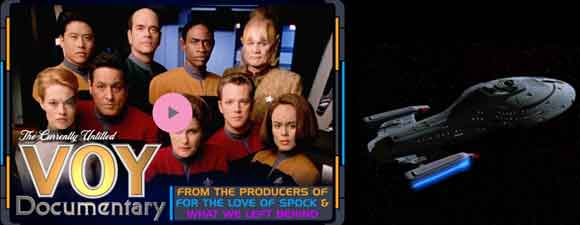Retro Review: Message in a Bottle
7 min read
messageinabottlebanner
A relay network allows Voyager to send the Doctor to the Alpha Quadrant, where he finds himself on an experimental ship overtaken by Romulans.
Plot Summary: Though Seven of Nine’s forceful manner has aggravated many crewmembers, Janeway and Chakotay respond to her summons to the astrometrics lab, where they are astonished to find that, using an alien relay network, Seven has located a Starfleet vessel on the outskirts of the Alpha Quadrant. Because conventional messages bounce back through the network, Janeway decides to transmit the Doctor’s more stable holographic matrix. The Doctor materializes on the USS Prometheus, where he finds that the experimental starship has been taken over by Romulans and the entire crew is dead. When a wounded Romulan comes to Sickbay, the Doctor pretends to have been activated at that moment, then summons Prometheus’s EMH – a brand new model who’s even more rigid than Voyager’s EMH was upon his first activation. While the Romulans fight among themselves about whether to deliver Prometheus to Romulus or to the Tal Shiar, the two doctors devise a takeover, using anesthetic gas to knock out the Romulans by means of Prometheus’s multiple emitters, which allow holographic crewmembers to materialize nearly everywhere on the ship. Meanwhile, on Voyager, Janeway and Chakotay write letters to send home to their families before discovering that the owners of the relay stations – a species called the Hirogen – don’t want intruders using their equipment. When diplomacy appears to be on the verge of failing, Seven transmits a pulse to knock out a Hirogen officer long enough for Voyager to retrieve the Doctor, who with his fellow EMH has used Prometheus’s multivector assault mode to fight off Romulan attackers and save a Starfleet rescue team. The Doctor informs Janeway that although Starfleet Command declared Voyager lost fourteen months earlier, the admirals promise to contact the families of the crew and work on a means to get them home.
Analysis: I remember the joy my corner of fandom experienced when “Message in a Bottle” first aired – not just because it’s the most solid episode thus far of the Seven of Nine era in terms of the balance of science fiction, drama, characterization, and humor, but because it seemed to be a tipping-off point for so many wonderful arcs, including the upcoming conflict with the mysterious Hirogen, the chance to expand upon and resolve relationships in the Alpha Quadrant, the transformative news of what had happened to Starfleet as the Dominion War began, and the changes in crew dynamics that would inevitably result from an encounter with each crewmember’s former life. A few people were disappointed that what was meant to be Voyager’s isolated mission had been altered because of this definitive contact with the Alpha Quadrant, and I admit that it’s aggravating we’re told about rather than shown the scene in which the Doctor spoke to Starfleet, during which he must have explained that the Maquis whom Janeway was sent to capture were now full members of her crew, and that the Voyager family had come to include a small child, a Delta Quadrant native, and a Borg-assimilated human, not to mention the Doctor’s own mobility via a futuristic mobile emitter acquired during a mission to the past to save Earth’s future. It was easy to overlook the brevity with which this monumental shift in status was addressed the first time around because we all assumed that there had been some careful planning for the future – that the writing staff must have sketched out a timeline for Starfleet’s next intervention, a design for what would happen to the crew feelings and relationships upon learning of changes back home, a new character bible describing how a link to the Alpha Quadrant ironically could free up those who had felt bound to obligations there. But because the producers were hoping to drag the series out for seven seasons, very little changed in the immediate aftermath.
The aspects of “Message in a Bottle” the work best are the bottle show aspects – the one-on-one interplay between the Doctor and the Prometheus EMH, the tightly-written conflict with the Romulans, and the revelation of a new class of starship with dazzling defensive capabilities. Robert Picardo and Andy Dick dominate the episode, playing two similarly pompous, prissy holograms each of whom feels he is superior to the other, and their mutual sense of outrage makes their reaction shots, perfectly framed and balanced, even funnier than their dryly witty dialogue. While Prometheus’s EMH insists that the original Doctor is obsolete, the first holodoc explains that he’s been on away missions and had sexual relations courtesy an addition he made to his program, at which point the Mark 2 switches from acting huffy to begging to download those specs himself. Even during the crisis on the bridge as the Romulans attack, the two continue competing and snarking at one another, until finally their mutual pride at not being limited by humanoid constraints leads to bonding and a sense of victory, even if they do accidentally shoot a Starfleet vessel. If it’s a little silly that a pair of computer-generated holograms can’t access the computer directly but must read the labels on buttons and press panels that don’t respond to their voice commands, it’s also a lot more fun to watch two guys shout instructions at one another than it would be if they merely screwed up their faces to concentrate and the computer responded. Similarly, as nice as it is to see Paris and Kim interact like the best friends they’re supposed to be, it’s preposterous that Kim gets as far as he does in an attempt to recreate a backup Doctor on Voyager; we’re told repeatedly in episodes like “The Swarm” that the Doctor can’t be replaced, and if he could, surely the crew would start with the diagnostic version. It would be nice to watch Torres quarrel with Seven, too, given that Seven now has some of the same problems getting along with colleagues that Torres once had, except that Seven’s always written as being right.
I’m glad that Janeway can still keep a sense of humor about being ordered around by Seven, but as much as I’m trying to keep my vow to appreciate Seven more this time around in a rewatch, Seven’s value feels inflated at the expense of Janeway every episode. Torres may sound a bit over the top at first, being furious at how Seven is allowed to get away with locking senior officers out of labs, but the fury later seems justified when Seven knocks out a Hirogen without warning, let alone permission or orders, without receiving one word of discipline. Since when does Janeway toss diplomacy aside so quickly and since when does she let her enfants terribles make decisions for her? It may be easier to understand, now that Starfleet’s involved, why crewmembers stick with an inconsistent captain rather than going off to live on a friendly planet along the way, but it also means that the crew must either reaffirm its commitment to Starfleet principles or accept that their lives in the Alpha Quadrant have already been irrevocably altered, so more dramatic change aboard the ship might be welcome. It’s hard in light of “Endgame” not to flinch every time Chakotay asks that Torres get along better with Seven or jokes fondly with the captain about Seven, which at one time seemed like indications of his closer relationships with the other two women facing a difficult new crewmember, but now could just as easily be read to mean that Chakotay, like Kim, is too distracted by Seven’s most obvious assets that he doesn’t care how much tension she’s brought aboard the ship.
And it’s hard not to wish there had been some follow-up elsewhere in the franchise about the Prometheus itself – a sophisticated warship whose most complex technical achievement, the ability to divide itself and conquer, can’t have been intended to seek out new life and new civilizations. Since the ship is evidently intended to fight in the Dominion War, of which Voyager’s crew is so blissfully unaware that that Doctor must ask what the EMH is talking about, how come there isn’t a proper follow-up to “Message in a Bottle” on Deep Space Nine? I assume this is the Prometheus’s first major test run, since only four people can pilot it, and apparently there are major problems with its shields and security, since the Romulans are able to kill every crewmember and take over bridge controls. I’d love to have seen a more concrete connection between Voyager and the rest of Star Trek by having this starship or another prototype appear in a then-current show or film – at the very least, some mention of this slaughter by the Romulans should have come up when Sisko was feeling guilty about assassinating a single Romulan to bring those frenemies into the war on the side of the Federation and protect the Alpha Quadrant from Dominion takeover. “Message in a Bottle” is still a well-written, enjoyable episode, but it’s less of a delight to watch now, knowing how much of its potential was never fulfilled.






